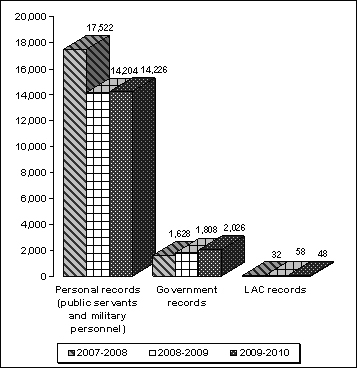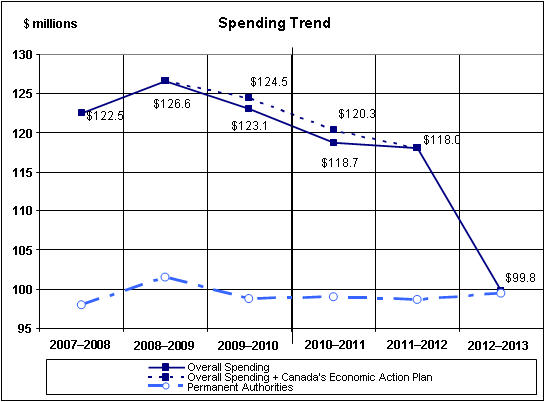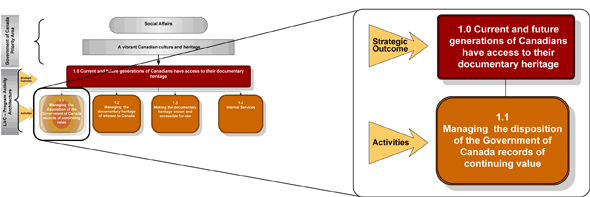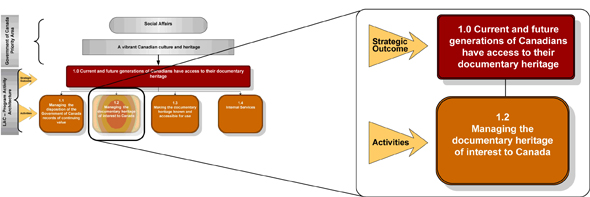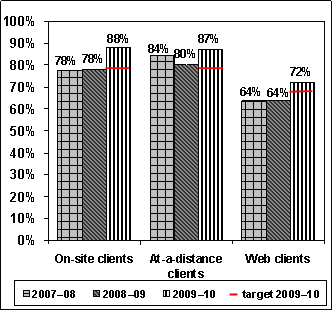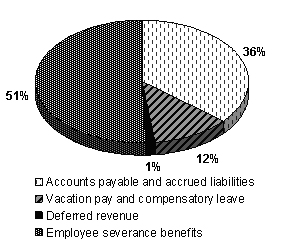ARCHIVED - Library and Archives Canada - Report
 This page has been archived.
This page has been archived.
Archived Content
Information identified as archived on the Web is for reference, research or recordkeeping purposes. It has not been altered or updated after the date of archiving. Web pages that are archived on the Web are not subject to the Government of Canada Web Standards. As per the Communications Policy of the Government of Canada, you can request alternate formats on the "Contact Us" page.
2009-10
Departmental Performance Report
Library and Archives Canada
The original version was signed by
The Honourable James Moore, P.C., M.P.
Minister of Canadian Heritage and Official Languages
Table of Contents
Section I: Departmental Overview
Section II: Analysis of Program Activities by Strategic Outcome
Program Activity 1.2 – Managing the documentary heritage of interest to Canada
Program Activity 1.3 – Making the documentary heritage known and accessible for use
Section III: Supplementary Information
Minister's Message

The Government of Canada recognizes that the cultural sector plays a vital role in building dynamic communities across Canada and contributes immensely to our economy. As a Canadian Heritage Portfolio agency, Library and Archives Canada (LAC) works to engage Canadians in a vibrant cultural and civic life and contributes actively to the administration of Canadian institutions in its role of official record keeper for the Government of Canada.
In particular, LAC is focusing on the modernization of its activities to reflect today's digital age in which Canadians are using new technologies to generate and access more information than ever before. Through its new Documentary Heritage Management Framework, Library and Archives Canada is redefining its key functions as well as its partnerships with other Canadian memory institutions. This approach allows it to increase its collaboration with users and creators to optimize resource discovery.
In 2009–2010, LAC also generated direct benefits for Canadians. For example, core support for a new government-wide record-keeping system improves Canadians' access to information. Co-operation with partners brought the LAC collection to more Canadians through initiatives such as Festival Karsh in Ottawa and Edmonton, as well as online. Portraits in the Street Vancouver 2010 reached 140,000 people in connection with the 2010 Vancouver and Whistler Olympic and Paralympic Winter Games. These and other initiatives demonstrated the organization's commitment to share our country's documentary heritage with Canadians.
As the Minister of Canadian Heritage and Official Languages, I am pleased to present the 2009–2010 Departmental Performance Report of Library and Archives Canada. This report illustrates LAC's activities during the last fiscal year.
The Honourable James Moore, P.C., M.P.
Section I: Departmental Overview
Raison d'être
The preamble of the Library and Archives of Canada Act states that the mandate of Library and Archives Canada (LAC) is:
- to preserve the documentary heritage of Canada for the benefit of present and future generations;
- to serve as a source of enduring knowledge accessible to all, contributing to the cultural, social and economic advancement of Canada as a free and democratic society;
- to facilitate in Canada co-operation among the communities involved in the acquisition, preservation and diffusion of knowledge;
- to serve as the continuing memory of the Government of Canada and its institutions.
Responsibilities
Documentary heritage takes many forms. What were once largely printed and recorded items such as books, historical documents, government records, photos, films, maps, music and documentary art are now increasingly digital: the websites, audio, video and social technology that capture today's Canadian documentary productions. Regardless of the format, sources or volume of documentary heritage generated by Canadians, LAC has three core responsibilities:
- acquisition
- preservation
- resource discovery
We are mapping out an integrated approach to all three as part of our modernization of LAC, which is described in more detail later in this section. This approach will take into account the following elements of each core responsibility.
Library and Archives Canada: Collection Figures
- More than 22 million books, periodicals, newspapers, microfilms, literary texts and government publications
- More than 167,000 metres of government and private textual records
- About three million architectural drawings, maps and plans
- About 25 million photographs
- About 355,000 hours of film, video and sound recordings
- Canada's portrait collection, which includes 21,000 works of art and thousands of caricatures
- More than 560,000 musical items
- More than 371,000 items from the documentary art collection, including watercolours, sketches, miniatures and oil paintings
- One million items from the philatelic collection
- More than one billion megabytes of digital content
Source: Library and Archives Canada
Acquisition
Figure 1: Number of government acquisitions transferred to LAC

Figure 2: Published items transferred to or acquired by LAC
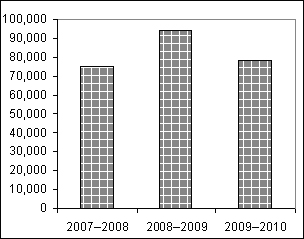
Figure 3: Number of archival acquisitions from private sector acquired by LAC
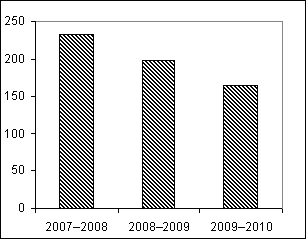
Acquisition is the result of an evaluation process that strives to find the most meaningful document from a world where information is overabundant.
Currently, there are three main acquisition processes at LAC. First, Government of Canada departments and agencies transfer to us their documents and records of archival or historic value. Second, legal deposit requirements in the Library and Archives of Canada Act obligate publishers to provide us with copies of materials published in Canada. The third process covers all other acquisitions, such as donations, purchases and our work to gather material online. The rapid growth in available materials demands that LAC take a more strategic approach regarding acquisition. LAC is doing this by focusing on items of historical value that contribute to the understanding of Canada's social, economic and cultural development, as well as by supporting effective recordkeeping in government departments. This more strategic approach is also taking place in ways that assess the likely implications of an acquisition on LAC's preservation and resource discovery responsibilities.
Preservation
The preservation function carried out at LAC encompasses activities that store, preserve and protect from damage the documentary heritage of Canada for the benefit of current and future generations. LAC's actions to ensure the long-term preservation of collection material begin at the point of acquisition and continue through the day-to-day management of the collection including the delivery of material to clients. These actions are carried out by staff with expertise in both analogue and digital collections using a wide range of technologies and systems. LAC's Preservation Centre has much of the infrastructure necessary for preservation and management of the collection. Given the variety and quantity of collection material that requires preservation, LAC takes a risk-based approach. For example, preservation is carried out based on priority factors such as fragility, obsolescence, value, meaningfulness of the document as well as client demand.
Resource Discovery
LAC's resource discovery focuses on client-driven processes that make it as easy as possible for Canadians to explore the collection on their own terms. Many Canadians are using Web-enabled searches of collection material as they pursue interests such as family history. LAC staff members organize exhibitions and learning events increasingly online or at partner sites across Canada.
Resource discovery is also linked to government accountability, through access to the Government of Canada digital, paper and other records that LAC manages. Access to information responsibilities often involve reviews of archival records, personnel records of former civilian and military government employees and business records. Our eight Regional Service Centres manage more contemporary records in all media in conjunction with more than 90 federal government organizations across the country. These Centres hold backup copies in case of disasters or emergencies.
The processes we use to describe the items in the collection are essential to resource discovery and are also models that other Canadian institutions use. Our development and use of effective, consistent description standards help Canadians understand elements of the collection, find documents of interest to them and add more information to those documents. This also helps clients understand how we have organized the collection and resources and assists them in their searches.
Strategic Outcome and Program Activity Architecture
Library and Archives Canada works toward the single strategic outcome set out in the following chart. It currently organizes its work through the program activity architecture (PAA) also set out in that chart.
It should be noted that while the work of LAC is generally aligned with the Government of Canada outcome of "Vibrant Canadian Culture and Heritage" in the Social Affairs outcome area, our department's recordkeeping responsibilities are also clearly supportive of the Government Affairs outcome area.
We expect a new PAA to be in place for 2011—2012 that will represent our most current understanding of LAC's core activities and an updated organizational structure designed to meet the responsibilities of our institution.
Summary of Performance
| Planned Spending | Total Authorities | Actual Spending |
|---|---|---|
| $121,338.9 | $140,078.8 | $124,467.5 |
| Planned | Actual | Difference |
|---|---|---|
| 1,132 | 1,140 | 8 |
| Performance Indicators | Targets | 2009—2010 Performance |
|---|---|---|
| Extent to which the LAC collection is accessible to Canadians (refers to going digital) | 2009—2010 determine baseline |
A conservative estimate of approximately 15 million images (0.3% of the collection content) is available online1. Among other measures of access are the following:
|
The performance indicator and target above is from the Performance Measurement Framework that LAC revised after the Report on Plans and Priorities (RPP) was completed. They were used throughout 2009—2010 and provide a more meaningful and measurable basis to define LAC's goals and results achieved than those set out in the RPP.
1 This result is comparable to other national institutions, such as the National Archives and Records Administration (NARA), which has a similar mandate to NARA. For more information on this topic, consult pages 38 to 45 of the LAC Fiscal Year 2010—2011, Annual Performance Plan at: [www.archives.gov/about/plans-reports/performance-plan/2011/2011-performance-plan.pdf]
| Program Activity | 2008—2009 Actual Spending |
2009—2010 | Alignment to Government of Canada Outcomes | |||
|---|---|---|---|---|---|---|
| Main Estimates |
Planned Spending |
Total Authorities |
Actual Spending2 |
|||
| Program Activity 1.1 - Managing the disposition of the Government of Canada records of continuing value | $13,938.8 | $9,863.6 | $9,860.7 | $11,192.9 | $11,248.2 | Social Affairs Vibrant Canadian Culture and Heritage (See Note 1) |
| Program Activity 1.2 - Managing the documentary heritage of interest to Canada | $68,776.8 | $57,301.0 | $57,287.8 | $70,401.6 | $54,509.8 | Social Affairs Vibrant Canadian Culture and Heritage |
| Program Activity 1.3 - Making the documentary heritage known and accessible for use | $43,876.9 | $24,611.8 | $24,612.0 | $26,107.1 | $24,305.9 | Social Affairs Vibrant Canadian Culture and Heritage |
| Program Activity 1.4 - Internal services | Note 2 | $29,606.2 | $29,578.4 | $32,377.2 | $34,403.6 | |
| Total | $126,592.5 | $121,382.6 | $121,338.9 | $140,078.8 | $124,467.5 | |
Note 1: While the Program Activity Architecture currently allocates all LAC program activities to the Social Affairs outcome, effective recordkeeping establishes an essential administrative and business foundation within government for services to Canadians. It is an essential element in supporting
ministerial and managerial accountability within Canada's democratic process. Therefore, LAC notes that Program Activity 1.1 aligns better to the Government Affairs outcome.
Note 2: Commencing in the 2009—2010 Estimates cycle, the resources for Program Activity 1.4: Internal services is displayed separately from other program activities; they are no longer distributed among the remaining program activities, as was the case in previous Main Estimates. This has affected the comparison of spending and FTE
information by Program Activity between fiscal years.
2 Financial variances are detailed in the Financial Performance Summary for 2009—2010 at: [www.collectionscanada.gc.ca/about-us/012-3001-e.html]
Modernization at LAC: Building for the Future
We live in an unprecedented digital information environment that is reshaping the documentary heritage of Canada. User-generated digital videos, audio, electronic publications, web pages, emails, social networking posts and much more have expanded a base that once consisted of various kinds of printed and recorded materials and included documentary art such as portraits. Digital technologies have also fundamentally altered how people gain access to information. Canadians now expect to be able to use digital technology to find anything, anywhere, anytime.
These factors are completely reshaping the work of LAC and other memory institutions in Canada as they ask what documentary heritage should be acquired, preserved and made available—not just for present-day users but for those of future generations, in 50 or 100 years, who want to understand the Canada of 2010. Such memory institutions are questioning how to get the best results possible from the multitude of choices given the likelihood that resources will remain roughly at current levels. They are asking each other how their traditional roles and relationships can evolve into more effective and efficient partnerships.
The digital reshaping of the information environment was already becoming clear by the late 1990s. The Government of Canada made a critical step forward when it created the Library and Archives of Canada in 2004 and assigned it the broad responsibilities noted in the "Raison d'être" above, as well as the flexibility to act strategically. Since then, LAC has taken a series of strategic actions to align its activities with the opportunities of a rapidly evolving environment.
LAC's Strategic Choices
LAC will adjust all aspects of its activities to adapt to the needs and benefit from the opportunities of the digital information environment.
LAC will increase the relevance of and accessibility to its collection and expertise for Canadians outside the National Capital Region.
LAC will focus its role in Government of Canada information management on the development of effective recordkeeping.
LAC will make systematic use of collaborative arrangements and will increasingly deliver on its mandate through or with others.
LAC will ensure that client research and evaluation results are built into management decision making.
In 2009—2010, LAC was concluding its focus on five Strategic Choices that had served as our departmental priorities since 2006. They are listed in the table immediately to the right of this section. The Strategic Choices articulated the direction of our institution. They guided us as we began to consolidate and concentrate our efforts on the results most relevant to our mandate and to the interests of Canadians. For example, they helped to shape a new Recordkeeping Directive for Government of Canada departments and agencies that is much more strategic, results-focused and cost-effective. The Strategic Choices guided initial strategies for the acquisition and preservation of Canada's digital documentary heritage. They influenced decisions as we tested new ways to make the collection accessible to Canadians, regardless of where they live, and often through partnerships with other institutions. They also inspired challenging decisions as we shifted resources from established uses to funding more compelling new opportunities. We tested many approaches in detail through "Pathfinder projects." They allowed us to better understand the practical issues involved in moving forward and the challenges we would have to manage.3
3 This process and related decisions regarding modernization are described in detail in the document Shaping Our Continuing Memory Collectively: A Representative Documentary Heritage posted at: [www.collectionscanada.gc.ca/lac/012007-1000.001-e.html]
The Outcomes, Guiding Principles and Roles
There was substantial internal analysis and discussion of the experience with the Strategic Choices, including the Pathfinders. It included an evaluation of our progress and the lessons learned from the Strategic Choices process since 2006. In November 2009, we released the following set of documents about the modernization of LAC:
- Library and Archives Canada's Story Continues;
- the Documentary Heritage Management Framework;
- the Acquisition Orientation Instrument.
The Documentary Heritage Management Framework defined five outcomes for our efforts:
- Canadians will identify with Canada's documentary heritage and see it as relevant.
- LAC will demonstrate a more disciplined, holistic and transparent approach to acquisition decisions with more effective use of resources.
- LAC will have a more responsive and agile organizational approach to business by structuring its activities along the business lines of acquisition, preservation and resource discovery.
- LAC will be the steward of a documentary heritage collection that can be sustained.
- Memory institutions across Canada will collaborate to meet the needs of Canadians for a more cohesive approach to their documentary heritage.
A major step in the direction of the above outcomes was the development of a more rigorous strategic approach based on the following guiding principles within the Documentary Heritage Management Framework.
- Significance focuses our attention on the documentary heritage that best represents the development of Canadian society and its identities, cultures, values and experiences.
- Sufficiency points us toward collecting Canada's documentary heritage in the quality and quantity adequate to meet our objectives.
- Sustainability emphasizes acquiring items that do not present preservation and access challenges.
- Society emphasizes the LAC commitment to document Canada's diverse society, and the importance of serving and benefiting Canadians through the use of the collection.
These four guiding principles extend to collaborating more strategically with other memory institutions and partners. This may lead to more defined responsibilities or priorities for LAC in relation to those of other memory institutions and partners as we all coordinate our respective documentary heritage management efforts to be more effective and efficient.
The next step was to begin developing three orientation instruments that would translate these principles and roles into practical guidance for our core responsibilities.4 We released the Acquisition Orientation Instrument with the initial set of documents in November 2009. The Preservation Orientation Instrument followed later. Work began on the Resource Discovery Orientation Instrument, for release later in 2010. Overall, our progress on modernization was achieved more rapidly than originally anticipated, which in turn accelerated the related change management of modernization.
4 The entire set of documents relating to the modernization of LAC is accessible at: [http://www.collectionscanada.gc.ca/modernization/index-e.html]
Consultations and Further Elaboration
An extensive consultation process followed the release of the modernization documents in November 2009. The Librarian and Archivist of Canada and other senior LAC officials consulted with Canada's library and archives communities, including their counterparts in provincial and territorial libraries and archives. Meanwhile, we aligned our new and previously committed actions with the direction of modernization. We placed greater emphasis on LAC-wide approaches to issues, rather than ones specific to a particular branch or group. We used the lens of modernization as a way to consider our options in such areas as the many information technology investments we could make.
Using the same lens, we placed a moratorium on purchasing new acquisitions between May 2009 and January 2010. Individual acquisitions after that were assessed on the basis of the four guiding principles of modernization, and included consideration of probable long-term preservation costs.
The modernization process will continue and evolve with experience. To support it, we established new operational and management priorities for the 2010—2011 fiscal year, taking into account the progress we have already made, and including the priorities reflected in the decisions and actions listed in the table below and others described in Part II of this report.
Contribution of Priorities to the Strategic Outcome
Between 2006 and 2010, the five Strategic Choices listed below were theLAC management and operational priorities. They served as broad guides in setting priorities for change and experimentation, not for specific and quantitatively defined time-based goals with precise targets. Each one emphasized a particular aspect of change in how LAC would seek to achieve its strategic outcome that Current and future generations of Canadians have access to their documentary heritage in a rapidly changing environment.
Given the end of that multi-year process and an evaluation of results to date, we can summarize the progress of each Strategic Choice between 2006 and 2009.
| Strategic Choice | Type | Status |
|---|---|---|
| LAC will adjust all aspects of its activities to adapt to the needs and benefit from the opportunities of the digital information environment. | Previously committed |
Somewhat met Between 2006 and 2009, we made some progress regarding certain aspects of our activities.
|
| LAC will increase the relevance of and accessibility to its collection and expertise for Canadians outside the National Capital Region (NCR). | Previously committed |
Mostly met Between 2006 and 2009, LAC made significant progress.
|
| LAC will focus its role in Government of Canada information management on the development of effective recordkeeping. | Previously committed |
Met all This priority is on track. We have reached the results that we projected when we established this Strategic Choice.
|
| LAC will make systematic use of collaborative arrangements and will increasingly deliver on its mandate through or with others. | Previously committed |
Somewhat met
|
| LAC will ensure that client research and evaluation results are built into management decision making. | Previously committed |
Somewhat met
|
5 For more information on LAC's RMAFs, consult the following link: [www.collectionscanada.gc.ca/about-us/014/index-e.html]
Risk Analysis
As an organization with a specific mandate and set of responsibilities, the LAC operating context during 2009—2010 was largely in line with projections at the time the Report on Plans and Priorities (RPP) was developed. As a result, the existing corporate risk profile used to shape plans and priorities for the year was an effective management guide. Those risks, of which the most significant are indicated below, were recognized as ongoing to LAC and our ability to achieve our strategic outcome, rather than short-term ones. The Strategic Choices were designed to help us better understand and explore approaches that would allow us to mitigate risks over the medium to long term. The modernization commitment, set out earlier in this section, was designed for us to learn from our experience in managing many of the key risks set out in the RPP and listed below.
- Preservation of digital and analogue documentary heritage — Modernization features an approach to acquisition and preservation that reflects our commitment to a collection that will continue to have analogue and digital items in old and new media. It sets priorities to guide the most appropriate choices and use of resources.
- Long-term accommodation and technological infrastructure — Modernization sets priorities that will provide an ongoing basis for assessing accommodation and infrastructure requirements and draws on the lessons learned with technology and infrastructure initiatives to date. It has already influenced the decision to build new, specialized infrastructure to house some of the LAC collection.
- Financial sustainability — Modernization is linked directly to ensuring that LAC can use its resources and leverage those of other partners to achieve the most strategically appropriate results. The one new development in 2009—2010 was the requirement to accommodate the Government's Strategic Review commitment to reduce ongoing expenditures, in our case by $800,000 in 2009—2010 and $4.6 million in 2010—2011. In response to this reduction, LAC has revisited its activity base and will continue to do so throughout 2010—2011 toward delivering its mandate in a more efficient manner.
- Human resources — We are pursuing human resource strategies based on the expectation that LAC staff, both current and future, will bring new skills to our organization, will increasingly reflect Canada's diversity, and will work in a more collaborative culture in line with the direction set out in the Documentary Heritage Management Framework. In addition, LAC needs to provide opportunities for experienced staff to transfer their knowledge and skills to new employees.
- Government-wide initiatives — The strategic nature of modernization will reinforce LAC's capacity to make appropriate contributions to government-wide commitments.
An internal audit on risk-management practices during the year focused on key aspects of risk, controls and governance processes in LAC. It yielded important insights for assurance reporting across the organization and provided recommendations to help improve LAC risk management.
Expenditure Profile
The chart below depicts LAC's spending trend over a six-year period (three years of actual spending and three years of planned spending). The higher level of spending over five years beginning in 2007—2008 stems from temporary funding for specific projects as described below.
- Over three years, beginning in 2007—2008, $21.7 million has been invested in replacing obsolete systems and providing the capacity for managing electronic publications and digital records of the Government of Canada;
- In 2008—2009, LAC received approval for the construction of a preservation facility that will safeguard Canada's cellulose nitrate-based documentary heritage (photographs and films). We spent $7.4 million in 2009—2010 and an additional $6.5 million will be spent in 2010—2011;
- We anticipate spending $12.8 million in 2010—2011 and $19 million in 2011—2012 to increase LAC's collection storage capacity6;
These projects advance LAC's mandate to safeguard Canada's documentary heritage. LAC continues to ensure the availability of preservation capacity to meet the needs of Canada's collection.
6 Note that these funding levels are subject to change. Further details will be provided in the next RPP and DPR.
Canada's Economic Action Plan
Over two years, beginning in 2009—2010, we received $3 million ($1.4 million in 2009—2010 and $1.6 million in 2010—2011) in funding under Canada's Economic Action Plan for the modernization of our federal laboratories7. The laboratories will be enhanced through the following construction work:
- Updating preservation and digitization laboratories in our Preservation Centre, which will increase their efficiency and flexibility and allow us to adapt those spaces to new technology;
- Renovating several archival processing laboratories in our Place de la Cité facility to provide environmentally appropriate and secure facilities in line with current technology needs.
Phase 1 of both projects was completed on schedule by March 31, 2010 and both projects are on track for completion in 2010—2011. Construction costs were below project estimates.
Upon conclusion of all these projects, spending will decrease by $18 million, LAC's approximate permanent funding level.
7 This figure excludes contribution to the Employee Benefit Plans as spending relates only to other operating and capital.
Figure 5: Financial spending trends
8Financial variances are detailed in the Financial Performance Summary for 2009—2010 at: [www.collectionscanada.gc.ca/about-us/012-3001-e.html]
Section II: Analysis of Program Activities by Strategic Outcome
This section presents the resources and results for each of the three program activities plus internal services under our single strategic outcome in 2009—2010:
Current and future generations of Canadians have access to their documentary heritage

Information in this section compares LAC performance to the Planning Highlights that were set out in the Report on Plans and Priorities (RPP) and the expected results, performance indicators and targets in the Performance Measurement Framework that LAC revised after the RPP was completed. These expected results, performance indicators and targets were used throughout 2009—2010 and provide a more meaningful and measurable basis to assess LAC's goals and results achieved than those in the RPP.
The Performance Analysis describes the strategic approach taken under each program activity during the year and notes any significant developments after the RPP was developed, particularly those related to LAC modernization. This section also describes the benefits for Canadians, indicates lessons learned under each program activity and describes any results supported by Canada's Economic Action Plan.
These criteria were used to assign a performance status for program activity commitments stated in the RPP.
Exceeded: More than 100 percent of the expected level of performance (as evidenced by the indicator and target or, in the absence of targets, planned activities and outputs) for the expected result or priority identified in the corresponding RPP was achieved during the fiscal year.
Met all: 100 percent of the expected level of performance (as evidenced by the indicator and target or, in the absence of targets, planned activities and outputs) for the expected result or priority identified in the corresponding RPP was achieved during the fiscal year.
Mostly met: 80 to 99 percent of the expected level of performance (as evidenced by the indicator and target or, in the absence of targets, planned activities and outputs) for the expected result or priority identified in the corresponding RPP was achieved during the fiscal year.
Somewhat met: 60 to 79 percent of the expected level of performance (as evidenced by the indicator and target or, in the absence of targets, planned activities and outputs) for the expected result or priority identified in the corresponding RPP was achieved during the fiscal year.
Not met: Less than 60 percent of the expected level of performance (as evidenced by the indicator and target or, in the absence of targets, planned activities and outputs) for the expected result or priority identified in the corresponding RPP was achieved during the fiscal year.
Program Activity 1.1
Managing the disposition of the Government of Canada records of continuing value
LAC, in collaboration with the Treasury Board Secretariat, leads in the development and implementation of the Government of Canada information management and recordkeeping system.
| 2009—2010 Financial Resources ($ thousands) |
2009—2010 Human Resources (FTEs) |
||||
|---|---|---|---|---|---|
| Planned Spending |
Total Authorities |
Actual Spending9 |
Planned | Actual | Difference |
| $9,860.7 | $11,192.9 | $11,248.2 | 155 | 177 | 22 |
| Expected Results |
Performance Indicators |
Targets | Performance Status |
|---|---|---|---|
| Relevant GC information is managed by federal institutions in a manner that is coherent and that demonstrates accountability to support the rights, obligations and privileges of Canadians. | Proportion of institutions that receives or maintains an acceptable or strong information management report card | Baseline to be determined in 2009—2010 | 41% reached these levels in Round VI of the Management Accountability Framework evaluation (34% in Round V) |
The expected results, performance indicators and targets are from the revised Performance Measurement Framework that LAC revised soon after the Report on Plans and Priorities (RPP) was completed. These were used throughout 2009—2010 and provide a more meaningful and measurable basis to define LAC's goals and results achieved than those in the RPP.
9 For detail on financial variances, please refer to the Financial Performance Summary for 2009–2010 at: [www.collectionscanada.gc.ca/about-us/012-3001-e.html]
| Performance Summaries by RPP Commitment | Performance Status |
|---|---|
| Monitoring and efficiency reviews of Records Disposition Authorities with federal institutions | Exceeded |
| Finalization of assessment projects | Met all |
| Completion and launch of public service recordkeeping training and tool kits | Mostly met |
| Implementation of the new storage model for government records | Mostly met |
| Identification and elimination of stored paper records of no value | Exceeded |
Performance Analysis
Our progress on this program activity in 2009—2010 was in line with our projections. Since 2006, we have worked with the Treasury Board Secretariat and many departments and agencies to define and implement a new Government of Canada recordkeeping system that will improve records management and generate more of the benefits for Canadians described on the following page. In a sense, this work anticipated the direction that LAC is now pursuing across all our activities through the Documentary Heritage Management Framework and modernization. It brings a more strategic orientation to decisions on what government records LAC acquires and manages and to the responsibilities that departments have for effective recordkeeping and information management.
During 2009—2010, we launched a five-year road map for our government records activities. A key focus was to support the successful implementation of the new Directive on Recordkeeping after its launch in June 2009. To support the implementation of the new Directive, LAC developed an assessment tool and tested it with five departments. Each department received a report with recommendations designed to assess their state of readiness for compliance with the Directive. We completed two other assessment projects to validate the principles and concepts needed to make the new recordkeeping system a success.
To further support implementation of the Directive on Recordkeeping across the government, we also provided departments with tools and information through classroom training; information sessions and presentations; meeting with the House of Commons Standing Committee on Access to Information, Privacy and Ethics; responding to 845 email and telephone requests for information as well as other requests from departments; and working with the Canada School of Public Service on a recordkeeping course for delivery in 2010—2011. Our symposiums on recordkeeping and information management made it possible for more than 700 participants from 60 organizations to share information and best practices.
The launch of the new recordkeeping system encouraged us to revisit our ongoing responsibility to develop the Records Disposition Authorities (RDAs) that govern how departments dispose of records that have no business value. By March 2010, we analyzed all RDAs signed since 2002 to identify the ones needing follow-up with departments to ensure compliance with RDA terms and conditions. We also analyzed 23 selected RDAs (target 20) to identify challenges and areas for improvement in the overall process that governs how departments identify and transfer records to LAC in the context of the new recordkeeping system.
One impact of the new approach to recordkeeping that has evolved since 2006 is that LAC focuses on ensuring that only government records of archival value are retained and, therefore, made more easily accessible to Canadians, while those of no value are destroyed, eliminating storage costs. We supported further progress in this direction with new entrance criteria on what records can be transferred to LAC and an initiative that reduced the intake of government records, in alignment with the direction set out in the LAC Documentary Heritage Management Framework. Since departments now have much clearer responsibilities for storage of most documents, we oversaw the implementation of new standing offers for storage space that give those departments cost-effective choices for their needs and we began work that may lead to a longer-term, public-private partnership approach to storage.
Having set clear standards for government records that we will accept under the new recordkeeping system, we still needed to make progress on examining and eliminating the records that we have in storage that have no enduring value. For example, exceeding its two-kilometre target, our "Clearing the Path" initiative allowed LAC to dispose of 2.1 kilometres of non-archival records. An additional 1.5 kilometres of records with no archival value were identified for future destruction, and a separate project focused on clearing through LAC's own documents. To support departments in this same kind of effort, a project with Health Canada's Quebec region helped to enhance the tools for working with departments to clear their legacy documents using a risk-based approach.
In line with our mandate to provide leadership and advice and to coordinate library services of federal institutions, we took steps to heighten the profile of those libraries throughout government and facilitate co-operation among them. For example, we promoted alignment of federal libraries services with the new Directive on Recordkeeping and the tools and guidelines stemming from it to ensure efficient management of all information resources in government.
Lessons Learned
We have learned the importance of extensive communication and consultation with partner departments across the government, particularly to bring about the kind of change required to meet the goals of the new recordkeeping system at an individual departmental level. We see the importance of keeping our partners assured that they have the right information at the right time and that we use the optimal communications channels and media to engage them. As government records increasingly become digital, we see the need to work more through multidisciplinary teams.
We applied the lessons learned from our work that culminated in the new Government of Canada recordkeeping system to our efforts related to defining future directions for federal libraries. Our main activity in this regard was the creation of the Assistant Deputy Ministers Task Force on the Future of Federal Libraries, with LAC and Health Canada acting as co-chairs. This high-level consultative approach drew on the process that has worked well in shaping recordkeeping change.
Benefits for Canadians
The identification and proper management of Government of Canada documents of archival or ongoing business value mean those documents can be found more easily when needed, which supports accountability and transparency. Our elimination of stored documents with no business or archival value saves the money formerly spent storing them and the future costs of having to acquire more storage space.
Program Activity 1.2
Managing the documentary heritage of interest to Canada
LAC acquires documentary heritage material for the collection in many ways. LAC staff describe and manage this material to ensure its long-term preservation and accessibility.
| 2009—2010 Financial Resources ($ thousands) |
2009—2010 Human Resources (FTEs) |
||||
|---|---|---|---|---|---|
| Planned Spending |
Total Authorities |
Actual Spending10 |
Planned | Actual | Difference |
| $57,287.8 | $70,401.6 | $54,509.8 | 513 | 497 | -16 |
| Expected Results |
Performance Indicators |
Targets | Performance Status |
|---|---|---|---|
| The management of the LAC collection is improved to enhance long-term access and to better reflect the Canadian experience. | Effectiveness of the collection management strategy as measured by the extent of development and implementation of a more strategic approach to our acquisitions | Baseline to be determined in 2009—2010 | Based on the 2009—2010 LAC acquisition priority strategy: Percentage of new archival and published material acquisitions in strategic areas identified by LAC Aboriginal: Archival: 1.82% which mostly met the 2% target Published: 1.7% which exceeded the 1.5% target Multicultural: Archival: 3.03% which mostly met the 4% target Published: 2% which mostly met the 2.5% target Digital: Archival: 6.06% which exceeded the 5% target Published: 17.3% which exceeded the 15% target |
The expected results, performance indicators and targets are from the revised Performance Measurement Framework that LAC revised soon after the Report on Plans and Priorities (RPP) was completed. These were used throughout 2009—2010 and provide a more meaningful and measurable basis to define LAC's goals and results achieved than those in the RPP.
10 For detail on financial variances, please refer to the Financial Performance Summary for 2009—2010 at: [www.collectionscanada.gc.ca/about-us/012-3001-e.html]
| Performance Summaries by RPP Commitment | Performance Status |
|---|---|
| Strategic Development - A new integrated documentation approach | Exceeded |
| Strategic Development - A new collection content strategy | Exceeded |
| Collection Management Tools and Supports - Develop the base for Trusted Digital Repository services and increase their use | Somewhat met |
| Collection Management Tools and Supports - Progress on AMICAN | Somewhat met |
| Collection Management Challenges - Strategic digitization | Somewhat met |
| Collection Management Challenges - A new digital records program | Somewhat met |
| Collection Management Challenges - Audiovisual migration | Not met |
| Collection Management Challenges - Web archiving strategy | Not met |
Canada's Economic Action Plan
Canada's Economic Action Plan allocated $3 million to Library and Archives Canada ($1.4 million in 2009—2010 and $1.6 million in 2010—2011). This funding is supporting renovations and improvements to LAC preservation and processing laboratories through two projects, both of which are on schedule for completion in 2010—2011.
LAC Preservation Centre
Renovations are taking place to several preservation and digitization laboratories in our Preservation Centre to respond to the preservation needs of analogue and digital media. The improvements range from the replacement of air conditioning systems to updating the electrical system. An improved telecommunications system is being installed to meet digital media requirements. Other
modifications are assisting us to make better use of existing laboratories and to consolidate space. The work will enhance laboratory spaces for multiple preservation purposes, allowing for increased flexibility and efficiencies to position us to accept new opportunities with partners and to adapt to future requirements and needs.
Place de la Cité
We are adapting several archival processing laboratories in our Place de la Cité facility to improve their mechanical and security systems. The modernization of these laboratories includes modifying the heating, ventilation and air conditioning systems to maintain the environmental levels required under international archival standards. The security systems will be enhanced so
that top-secret level government records can be received and processed.
Performance Analysis
Our commitment to modernization and the work that preceded it had a significant impact on this program activity in 2009—2010. Our goal at the time the RPP was drafted was to move to a more strategic approach in terms of our acquisition activities and to build elements of the infrastructure for an increasingly digital collection-on top of ongoing preservation responsibilities.
As modernization took shape, we began to define a more strategic orientation for our preservation activities. The new acquisition and preservation orientation instruments seek to align our strategies and actions with overall collection priorities. For preservation, this involves three elements: increasing our digital capacities to preserve and access materials; implementing a whole-collection approach to preservation decisions, rather than looking at items based largely on what kind they are; and sharing efforts in a stronger preservation community across Canada. These actions affected the three major areas of attention in this program activity set out in the RPP.
Strategic Development
As part of modernization, the decision to develop and begin implementation of a comprehensive new Documentary Heritage Management Framework and Acquisition and Preservation Orientation Instruments replaced our original plans to develop and implement a new integrated documentation approach and a new collection content strategy. Since we anticipated moving toward a new approach to acquisition decisions, we placed a moratorium on new purchases between May 2009 and January 2010. This ensured that we did not spend money on acquisitions outside the new modernization principles described in Section I.
After the Documentary Heritage Management Framework was released, we launched new Pathfinder pilot projects and consultations with stakeholders. These led to a clearer sense of the challenges we may face as we take a more strategic approach to acquisitions and as we use collaborative approaches more routinely. We brought a new level of coordination to our collection development activities, with all acquisitions now being assessed against the four guiding principles of significance, sufficiency, sustainability and society, as defined in Section I. An internal audit review of acquisition processes has taken place, which will be finalized in 2010—2011. It is expected to provide recommendations that should support the further improvement of these activities.
Collection Management Tools and Supports
This area of attention relates to ongoing work, particularly through two initiatives.
First, we made progress on our commitment to establish a Trusted Digital Repository (TDR), which will allow the submission of electronic material to LAC online for long-term preservation and access to that material. This past year, we developed policies and guidelines on digital file formats for transfer and preservation for future users. We organized the International Internet Preservation Consortium Conference held in May 2009 in a collaborative effort to advance the preservation of digital content. We also progressed in developing the TDR component for electronic publications. However, in spite of our planning to receive government e-Records in the summer of 2010, technical challenges slowed our work, which generated fewer results than anticipated.
Second, we continued our ongoing commitment to AMICAN, which is LAC's integrated information management system. During the year, progress was made on all four major components of the system. As a result, much of our genealogical data is accessible online, clients visiting our Ottawa location can self-register, and most of our data on physical management of our holdings are contained in one database. In addition, significant progress was made to update the interlibrary loan and circulation systems and to make more information available through our online search.
11 For more detail on the Trusted Digital Repository, consult the following link: [www.collectionscanada.gc.ca/digital-initiatives/012018-4000.01-e.html]
Nitrate and Collection Storage Facility Projects
During 2009—2010, we made important progress to put infrastructure in place that will better safeguard Canada's documentary heritage and manage vital government records.
In July 2009, we began construction of a new nitrate preservation facility. It will ensure that Canada's heritage on nitrate-based media, such as old motion pictures, is cared for in the proper environment. When the material is moved into the new facility in late summer or early fall of 2010, it will be preserved in a site that meets current safety codes and preservation standards.

Nitrate preservation facility construction, November 13, 2009
Photographer: Gordon King
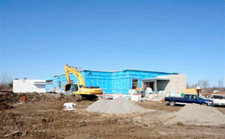
Construction of nitrate preservation facility, March 21, 2010
Photographer: Gordon King
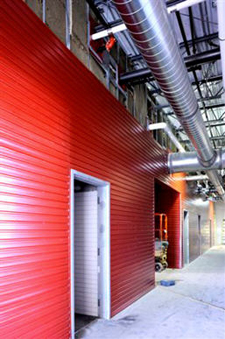
Inside the nitrate preservation facility, March 2, 2010
Photographer: Gordon King
Collection Management Challenges
The RPP set out a variety of commitments, all focused on our digital priority. The results expanded the amount of digital material in our collection, including both "born digital" items such as websites and electronic documents and those digitized or reformatted from other media.
Our work to digitize material already in our collection went somewhat slower than planned due to technical issues. However, more than 80% of the expected digitization took place. We created 2.8 million digital images internally and, through partnerships, created another 1.9 million images, all to be made accessible on our website. As part of this, 236,000 pages of Canadian publications were scanned, such as city directories, sheet music, French-language newspapers and broadsheets and posters.
A new audiovisual migration strategy and implementation plan describe LAC's approach to the migration of audio and video recordings from obsolete formats (such as tapes and discs) to computer file formats for long-term preservation. The strategy assigns priority for migration to those formats most at risk, with the most obsolete and the most challenging formats to be migrated first. About 4,400 hours of recordings have been migrated since the launch of the first migration projects in December 2009. The RPP target of 18,000 hours was based on an earlier start to projects and more resources than proved to be available.12
We had success in our efforts to acquire and preserve new digital materials. For example, a pilot project tested issues in transferring Government of Canada electronic records and assessed how we can best manage records such as those in common computer system directories, email and social media. We also expanded our collection of websites, for example, working with the Department of Canadian Heritage to capture sites related to the 2010 Olympics and Paralympics. This Web archiving began to shift to be more in line with the Documentary Heritage Management Framework and our Digital Collection Development Policy, which meant that a formal Web archiving strategy was not yet developed as was expected when the RPP was drafted.
Lessons Learned
While we are still in the early stages of identifying how best to implement the new Documentary Heritage Management Framework and its Acquisition and Preservation Orientation Instruments, the 2009—2010 experience demonstrates that information technology is a critical element in meeting expectations. We have faced more challenges in moving from old information systems to new integrated ones than we anticipated when these ideas were first developed, and in moving items in the collection from old formats to new digital ones. Given how many LAC commitments depend on IT systems and support, the Framework needs to proceed with the most strategic use of IT resources and well-planned new investments. The discussion under Program Activity 1.4 (Internal services) demonstrates that LAC is acting to address these lessons.
It is also apparent that we will need to clearly identify the human resources implications of the shifts anticipated in the Documentary Heritage Management Framework for acquisition and preservation. We will need to build the competencies that our staff require for working in such a digital information environment.
Most fundamental is the continuing lesson that LAC cannot achieve its responsibilities for acquisition and preservation alone and in relative isolation from other memory institutions. It is critical to build more collaborative relationships and work with other institutions to identify how best to share the responsibilities for managing Canada's documentary heritage.
Benefits for Canadians
Under the new Documentary Heritage Management Framework, we are bringing a consistent and sustained coordination to our acquisition, preservation and resource discovery activities. Our goal is a collection that becomes increasingly representative of Canada and its diversity, as well as accessible to Canadians and others interested in the story of Canada, all with the most efficient use of our resources. LAC develops national standards that documentary heritage organizations across Canada use to describe items, creating consistent ways for Canadians to find those items more easily. Our commitment to digitizing items is ensuring access for current and future generations of Canadians to that heritage, regardless of technological change and in line with our collection priorities.
12 For more detail on the Library and Archives Canada Audiovisual Migration Strategy, consult the following link: [www.collectionscanada.gc.ca/preservation/003003-1100-e.html]
Program Activity 1.3
Making the documentary heritage known and accessible for use
LAC provides information and services to facilitate access to the collection and pursues initiatives to make known and interpret Canada's documentary heritage. LAC also provides information resources and standards for use by Canada's library and archival communities.
| 2009—2010 Financial Resources ($ thousands) |
2009—2010 Human Resources (FTEs) |
||||
|---|---|---|---|---|---|
| Planned Spending |
Total Authorities |
Actual Spending13 |
Planned | Actual | Difference |
| $24,612.0 | $26,107.1 | $24,305.9 | 230 | 230 | 0 |
| Expected Results |
Performance Indicators |
Targets | Performance Status |
|---|---|---|---|
| Canadians are aware of LAC as an authoritative, innovative source of content and expertise related to Canada's documentary heritage | Percentage of clients who identify LAC as an authoritative, innovative source of content and expertise related to Canada's documentary heritage | Baseline to be determined in 2009—2010 | Results of a March 2010 survey indicated that 2% of Canadians are aware that Library and Archives Canada is the organization responsible for collecting, preserving and making accessible publications and records of importance to Canada. A further 16% of Canadians identify a similarly named institution as having this responsibility (names such as the National Library, Archives Canada or National Archives). |
The expected results, performance indicators and targets are from the revised Performance Measurement Framework that LAC revised soon after the Report on Plans and Priorities (RPP) was completed. These were used throughout 2009—2010 and provide a more meaningful and measurable basis to define LAC's goals and results achieved than those in the RPP.
13 For detail on financial variances, please refer to the Financial Performance Summary for 2009—2010 at: [www.collectionscanada.gc.ca/about-us/012-3001-e.html]
| Performance Summaries by RPP Commitment | Performance Status |
|---|---|
| Highlight and present digitized collections | Mostly met |
| Make the Portrait Gallery of Canada collection more accessible | Met all |
| Support the Learning Centre | Met all |
| Partner with others to reach audiences | Somewhat met |
| A new services strategy | Somewhat met |
| Gather client information | Met all |
Performance Analysis
Key to this program activity is how we identify and define our services. In the past, energies were often directed to supplying services to individuals on a one-to-one basis. LAC is increasingly focusing on activities and services that allow us to serve many clients at a time and is creating products, tools and services with multiple uses for "one-to-many" service.
We achieved an 88% satisfaction rate from clients using our services in person and an 87% satisfaction rate from clients "at-a-distance." Comments from clients have identified timeliness of services as the major concern, while the helpfulness of LAC staff is often noted. Results of an online survey found that client satisfaction with our Web content increased from 64% last year to 72% in 2009—2010. A separate survey of the library community found it to be generally very satisfied with our interlibrary loan services. We continued to benefit from the advice of the Services Advisory Board on improving client-centred services, including offering clients the opportunity to give us feedback on the modernization documents.
However, during 2009—2010, the service strategy development was recast in part because of the concurrent creation of the Resource Discovery component of the Documentary Heritage Management Framework. The development of the service strategy will now continue and the content will be integrated into the Resource Discovery Orientation Instrument, to be released in 2010—2011.
As events and activities designed to reach Canadians and specific audiences are substantially designed and planned well before a fiscal year begins, it was possible to deliver on the commitments set out in the RPP for 2009—2010. Many of those commitments demonstrated our ongoing balancing of support for one-to-one services, centred in the National Capital Region, and support for one-to-many services, which makes resources accessible to Canadians, regardless of where they are.
We launched new virtual exhibitions, such as History of the Book in Canada, and put databases online, such as the 1976 Cabinet Conclusions database and an improved version of the Canadian Naturalisation 1915-1932 database. Our support for improved digital access included the start of microform digitization of two popular collections for genealogical use. Our commitment to reach more people with the collection through social media was shown with updates to our Flickr channel: Sir John A. Macdonald and Images of the First World War14. While we achieved much of what we planned in this area, resource constraints limited our ability to deliver more.
Our commitment to make the Portrait Gallery Program more accessible benefited greatly from collaboration with other institutions. For example, Festival Karsh, our collaboration with the Canada Science and Technology Museum, attracted 67,000 visitors. It was complemented by a self-directed Ottawa walking tour of related Karsh sites, a website including an online gallery of the photographer's work, and "My Karsh," in which the public was invited to share their Karsh portraits on Flickr and their stories. The "Karsh: Image Maker" exhibition went on to be shown at the Art Gallery of Alberta from January to May 2010, where it attracted 45,000 visitors by early April. This exhibition received the Canadian Museum Association's Award of Outstanding Achievement15. In conjunction with the Winter Olympics and Paralympics, we offered "Portraits in the Street Vancouver 2010," which included 23 portrait reproductions of Canadian Olympians, Paralympians, and others who contributed to Canada's winter sport heritage. The portraits were located on Granville Island from January 28 to March 22, 2010 and were viewed by over 140,000 visitors.
Our LAC Learning Centre16 reached more than a thousand teachers at educators' conferences in Halifax, NS and Richmond, BC and generated a 75% increase in subscriptions to our electronic mailing list after exposure at conferences, education faculty workshops, teachers' professional development days and resource fairs. Users benefited from four new online resources and a new teaching kit on the Prime Ministers of Canada. We worked with Veterans Affairs Canada, the Historica Foundation and other partners through diverse Lest We Forget initiatives that allow Canadian students to understand the experiences of Canada and its military personnel in past wars.
This same collaborative approach to resource discovery was demonstrated in other ways. We worked with The Generations Network on digitizing 200 sets of military service files and border entry records, including over one million images. Our TD Summer Reading Club program17 continued in 11 participating provinces and territories with 519,000 children participating in activities and programming at almost 2,000 local libraries. Participation rates in Quebec almost doubled, coinciding with the introduction of content created by a committee of francophone librarians. Through the National Archival Development Program (NADP),18 a grants and contributions program administered by LAC and the Canadian Council of Archives, $1.1 million was approved in 2009—2010 for archival network capacity building to improve access to Canada's documentary heritage. In collaboration with Bibliothèque et Archives nationales du Québec, we developed a plan for "That's My Family,"19 which provides access to information on genealogy. We facilitated the digitization of Justice Canada tobacco litigation documents that will be available on our website. Although we seized many opportunities to collaborate with others in making LAC's collection known to the public, these initiatives were determined on an ad hoc basis. LAC is continuing to develop a collaborative approach to systematically increase its collaborative partnerships.
14 To know more about these virtual products, consult the following websites:
History of the Book in Canada [www.collectionscanada.gc.ca/databases/hbic/index-e.html]
1976 Cabinet Conclusions [www.collectionscanada.gc.ca/databases/conclusions/index-e.html]
Canadian Naturalisation 1915-1932 [www.collectionscanada.gc.ca/databases/naturalization-1915-1932/index-e.html]
LAC's Flickr channel [www.flickr.com/photos/lac-bac/]
15 To know more about the Portrait Gallery of Canada's virtual offerings, consult the following websites:
Portrait Gallery of Canada [www.collectionscanada.gc.ca/portraits/index-e.html]
Festival Karsh [www.festivalkarsh.ca/]
Flickr: My Karsh [www.flickr.com/groups/mykarsh-monkarsh/]
Canadian Museum Association's Award of Outstanding Achievement [www.collectionscanada.gc.ca/whats-new/013-460-e.html]
16 To know more about the Learning Centre, consult the website at: [www.collectionscanada.gc.ca/education/index-e.html]
17 To know more about the TD Summer Reading Club program, consult the website at: [www.td-club-td.ca/index-e.html]
18 To know more about the NADP, consult the website at: [www.collectionscanada.gc.ca/archives/042-200-e.html]
19 To know more about "That's My Family," consult the following URL: [www.thatsmyfamily.info/Metamoteur/explications_en.html]
Lessons Learned
Balancing resource discovery activities and resources to support existing and new services will be challenging. Our recent success in collaborating with others (e.g., Festival Karsh) demonstrated an excellent model for programming and service delivery, and should be expanded to support greater access for Canadians across the country. These efforts are to be augmented by various opportunities, including those that are digital, to provide relevant experiences and reproducible educational resources.
Any transition involves providing the time and staff resources necessary to work on the tools that deliver services to the greatest number of Canadians. This investment comes with a short-term impact on services. However, the investment will generate longer-term results by having more Canadians make use of the collection. It will provide Canadians with the tools to make access simpler and more effective through more digital opportunities.
A final lesson is that we will need to improve the practices we use to gather in-person client feedback. We need to explore less labour-intensive processes in this regard.
Benefits for Canadians
Canadians are increasingly taking advantage of improved access to LAC's collection through its online exhibitions, use of partner facilities and expanded resources for users. Canadians are benefiting from LAC's commitment to respond in a timely way to the interests of clients, such as those related to genealogy, education, and Access to Information and Privacy requests. LAC's focus on collaborative activities and partnering has enhanced access in such ways as the creation of new databases and the expansion of existing ones to facilitate client research.
Program Activity 1.4
Internal Services
LAC internal services such as human resources, information technology, infrastructure and communications are critical to overall strategies to achieve results for Canadians and ensure more consistent, corporate approaches to key challenges.
| 2009—2010 Financial Resources ($ thousands) |
2009—2010 Human Resources (FTEs) |
||||
|---|---|---|---|---|---|
| Planned Spending |
Total Authorities |
Actual Spending20 |
Planned | Actual | Difference |
| $29,578.4 | $32,377.2 | $34,403.6 | 234 | 236 | 2 |
| Performance Summaries by RPP Commitment | Performance Status |
|---|---|
| Governance and Management Support — Reduce number of policies | Mostly met |
| Governance and Management Support — A new approach to partnering | Mostly met |
| Governance and Management Support — Improved corporate research capacity | Met all |
| Governance and Management Support — LAC evaluations | Met all |
| Resource Management Services — An integrated human resources plan | Met all |
| Resource Management Services — Recruitment | Mostly met |
| Resource Management Services — Develop an information technology architecture | Mostly met |
| Resource Management Services — Technology to support digital initiatives | Met all |
| Resource Management Services — Senior-level IT committee | Mostly met |
| Resource Management Services — Improved LAC information management | Mostly met |
| Asset Management Services — Accommodate the collection in appropriate conditions | Met all |
| Asset Management Services — Launch a nitrate preservation facility | Met all |
| Asset Management Services — Allocate space by eliminating records | Exceeded |
20Financial variances are detailed in the Financial Performance Summary for 2009—2010 at: [www.collectionscanada.gc.ca/about-us/012-3001-e.html]
Performance Analysis
In general, the internal service commitments made in the RPP were substantially fulfilled by the end of the fiscal year or were on track to completion. While many of those commitments predate the development of the Documentary Heritage Management Framework, the LAC modernization process brought into focus the important contribution of internal services, such as information technology and human resources. It underlined the importance of planning, policy and governance action related to priorities such as partnerships and the need to reduce the "web of rules" that can slow LAC responses to opportunities. Other commitments, particularly those related to new construction projects, were the result of years of planning and relate to needs that will continue, regardless of the detailed direction of modernization.
Governance and Management Support
We acted on a wide range of commitments designed to strengthen LAC governance and the support that managers need for effective decisions. For example, we began to assess current LAC policies and procedures that will allow us to cancel outdated policies, while a new Policy Development and Management Framework will guide us in making future LAC policies. We also created a new Framework on Managing Partnering Activities to outline roles and responsibilities in LAC for the expanded use of partnership that we expect through modernization. A Strategic Research unit was created to scan, analyze and report on emerging trends affecting LAC and our policies, especially on complex horizontal issues to help meet institutional and Government of Canada strategic outcomes. Establishment of a Departmental Audit Committee began to provide LAC management with, as its charter states, "independent, objective advice, guidance and assurance on the adequacy of the Department's risk management, control and governance processes."
As part of our strengthened commitment to the use of evaluation to inform decision making, an evaluation examined LAC's experience with the five Strategic Choices that served as corporate priorities since 2006. Its findings are already informing aspects of the current modernization initiative. Although not committed in the RPP, a new Performance Management Framework and Program Activity Architecture were developed and will be fully in place for the 2011—2012 Estimates Cycle.
Resource Management Services
LAC addressed two critical but very different types of resources, each essential to the direction being set through modernization. The first type addressed LAC's human resources priorities through actions such as a LAC management-approved integrated human resource plan and the use of post-secondary recruitment to staff recent graduates into Historical Researcher positions. We have reviewed our critical positions to target the future needs and the required competencies of the organization, as well as setting the stage for knowledge transfer and other measures. In addition, a new approach is addressing our employment equity commitments by requiring that all staffing actions that are open to non-LAC employees include specific actions that could improve representation gaps.
The second type addressed the management, infrastructure and decision making related to the information technology (IT ) that is critical to an organization that works in an increasingly digital environment. Much of this activity supported initiatives described elsewhere in this DPR, such as support for the Trusted Digital Repository and a new Collection Management System. More generally, we continued to develop a process to ensure that our IT architecture is aligned with business objectives and we managed existing IT projects to ensure that priority was given to the most significant ones for LAC. This was supported by a new senior-level committee to oversee LAC digital initiatives and technology issues.
LAC launched a new recordkeeping and information management (IM) strategy that will continue until 2012 to ensure that we fully meet the new government-wide Directive on Recordkeeping. We matched that with action and training on specific IM issues within LAC, such as management of emails and information in shared computer directories and began training on IM under the new recordkeeping system, although development of the anticipated IM policy was deferred to 2010—2011. An analysis of LAC business processes began, aimed at finding consistent ways to identify documents of ongoing business and archival value.
Asset Management Services
As described in detail under Program Activity 1.2, LAC has managed major construction projects that were on time and on budget at the end of 2009—2010. We are also addressing demands for storage space through initiatives that are eliminating records from government departments that have no archival value, as noted under Program Activity 1.1.
Lessons Learned
LAC's internal services capacity is constrained by overall resourcing levels. Therefore, the continued development and use of management tools that allow priorities to be set and updated as necessary and that address the most critical risks to the achievement of corporate and government-wide goals is imperative.
Benefits for Canadians
Effective management of internal services allows LAC to act more effectively toward the achievement of our mandate under all program activities. For example, our progress on information technology improvements means that we focus our resources on the initiatives most likely to generate results for Canadians wanting to explore and use our collections, and that are in line with corporate priorities. Our progress on human resource issues is part of ensuring that we have the employee skills and expertise necessary to meet the changing needs and expectations of Canadians interested in Canada's documentary heritage. Improved facilities ensure that we care for the collection in the most appropriate environments for fragile items. Evaluation products, reports and advice support evidence-based decision making by LAC management.
Section III: Supplementary Information
Financial Highlights
The financial highlights presented with the Departmental Performance Report are intended to serve as a general overview of LAC's financial position and operations. Financial statements are prepared in accordance with accrual accounting principles. The unaudited supplementary information presented in the financial tables in other sections of this report was prepared on a modified cash basis of accounting in order to be consistent with appropriations-based reporting. The organization's financial statements can be found on LAC's website at: [www.collectionscanada.gc.ca/about-us/012-2001-e.html]
| Condensed Statement of Financial Position At End of Year (March 31, 2010) |
% Change | 2010 | 2009 |
|---|---|---|---|
| Assets | |||
| Total Assets | 32.3% | 56,407 | 42,641 |
| Total | 32.3% | 56,407 | 42,641 |
| Liabilities | |||
| Total Liabilities | -26.9% | 31,670 | 43,352 |
| Equity | |||
| Total Equity | 3,579.2% | 24,737 | (711) |
| Total | 32.3% | 56,407 | 42,641 |
| Condensed Statement of Financial Operations At End of Year (March 31, 2010) |
% Change | 2010 | 2009 |
|---|---|---|---|
| Expenses | |||
| Total Expenses | -12.1% | 151,482 | 172,369 |
| Revenues | |||
| Total Revenues | 14.2% | 637 | 558 |
| Net Cost of Operations | -12.2% | 150,845 | 171,811 |
Figure 7: Assets by Type
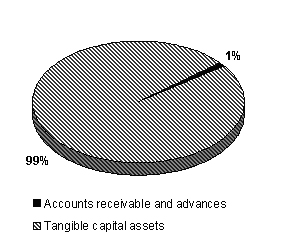
Total assets were $56,407 million at the end of 2009—2010, an increase of $13,766 million (32.3 percent) versus last year's total assets. Capital assets continue to be the largest asset component, representing 99 percent of assets.
Figure 8: Liabilities by Type
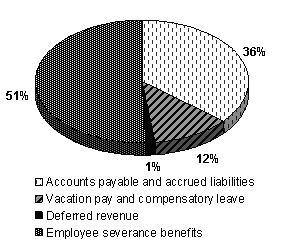
Total liabilities were $31,670 million at the end of 2009—2010, a decrease of $11,682 million (26.9 percent) versus last year's total liabilities. Employee severance benefits and accounts payable continue to be the largest components of liabilities.
Total expenses were $151,482 million at the end of 2009—2010, a decrease of $20,887 million (12.1 percent) versus last year's total expenses. The major expense area is salary and employee benefits, which represents 55 percent of total expenses.
List of Supplementary Information Tables
Green Procurement
Internal Audits and Evaluation
Sources of Respendable and Non-Respendable Revenue
Summary of Capital Spending by Program Activity
All electronic supplementary information tables found in the 2009—2010 Departmental Performance Report can be found on the Treasury Board of Canada Secretariat's website at: [www.tbs-sct.gc.ca/dpr-rmr/st-ts-eng.asp].
